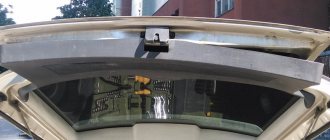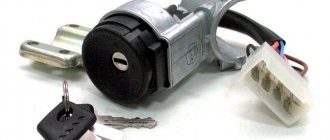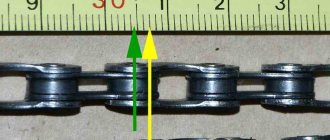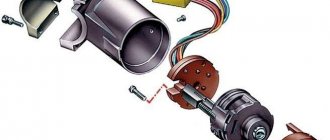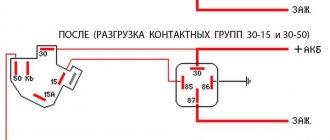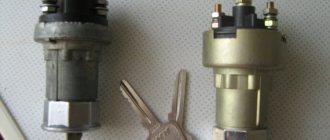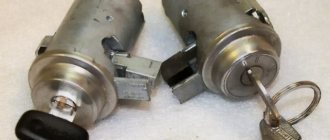What is he like?
Here is a unit used on GAZ, ZIL, Moskvich, Volga cars and other models produced in the USSR.
The ignition switch is used to connect consumers of electrical energy to the vehicle’s on-board network; it turned on the starter to crank the crankshaft and start the power unit. The design of the device did not have any means of protection against car theft. In case of failure, it is enough to remove the wires from the contact plates, to continue movement, just short them together.
If you can’t turn the starter, don’t despair too much. This can happen due to deformation of the key itself or jamming of the larvae. Before disassembling the switch, try resuscitation. WD fluid is well suited for this purpose; it should be injected into the cavity of the faulty ignition switch. Sometimes lightly tapping the body restores the switch's functionality. Difficulties in turning the key may be caused by natural wear and tear on the lock slats. If there is a second copy of the key, compare them and make sure the products are identical. If noticeable wear is detected, order a duplicate of the product.
The appearance of the first VAZ models showed drivers a completely new design of the device. He had a vehicle anti-theft device. After pulling out the key, the steering wheel locked, making it impossible to continue driving. In the era of fuel shortages at gas stations, drivers turned off the ignition while driving to save gasoline; as a result, the steering was blocked, leading to emergency situations.
The photo shows a representative of the VAZ 2101-2107 family of switches.
This model is not a problem-free product; breakdowns occur in such units. Moreover, problems occur in the contact group, the locking mechanism, jamming occurs, and the lock cylinder falls apart. Contact group problems are easily solved. The wires are removed, and consumer circuits are switched manually. You can continue driving for a long time; the car’s protection against theft becomes practically zero.
To prevent the steering wheel from jamming, you should remove the inoperative device from its seat. This operation will require several Phillips and flat blade screwdrivers. First of all, you should remove the plastic steering column cover and disconnect the wiring. The switch is fixed with screws, they should also be unscrewed. Next, use a thin screwdriver with a flat blade to press the latch in and remove the product out.
To replace the larva you need to disassemble it, you will need:
- Drills with a diameter of 2 and 4 mm;
- An awl with a strong tip, 30-40 mm long;
- Small side cutters, knife.
Procedure for replacing the larva:
- The chrome cover is rolled in three places; it needs to be bent and removed;
- A locking pin is found under the cover; it should be removed;
- A hole is drilled next to it with a 4 mm drill approximately 2 mm deep;
- In this recess, a hole is drilled with a smaller drill, but at an angle to the pin;
- When the drill reaches it, drilling is stopped;
- Now an awl comes into play, they push the pin out;
- Use the sharp tip of a knife to remove the faulty larva.
Reassembly must be done in reverse order.
Information about the design of the starter and its supply wiring
An automobile starter is attached to the engine block and is designed to impart rotation to the crankshaft through a ring gear on the circumference of the flywheel. The main components of the starter:
- An electric motor consisting of a rotor, a stator and a brush unit that powers the rotor windings.
- Freewheel with drive gear (Bendix). This also includes the simplest mechanism that moves the coupling along the shaft.
- Solenoid relay. A powerful solenoid that controls the supply of the clutch and also closes the power contacts of the electric motor.
Two electrical circuits are connected to the starter, a power supply and a control or signal circuit. The first supplies all the energy consumed during operation, and the second serves to turn the device on and off.
Starter operation in normal mode
When the driver gives a command to start the engine, the ignition switch contacts that switch the starter are closed, and voltage is supplied to the control relay. It is used to unload the contact group of the lock from high currents of the pull-in winding. Sometimes this relay is missing, then the ignition switch is made more massive, capable of switching without being burned by significant currents.
After the relay or ignition switch, if it is absent, the signal comes to the control contact of the solenoid relay. Both of its windings are triggered, after which the retractor is excluded from the circuit, and the retainer continues to supply power through the power contacts to the electric motor. At the same time, due to the movement of the solenoid armature, the freewheel engages with the flywheel, imparting rotation to it from the starter. When the engine starts, it throws the clutch back, thereby preventing the starter from “racing” at high uncontrolled speeds. The driver turns off the starter, removing the voltage from the holding winding, the spring returns the solenoid armature to the forward non-working position. Sometimes this is done automatically by control electronics.
Lockout triggered
Any modern car is equipped at the factory with a special steering wheel locking mechanism. This is one of the protective measures that are designed to prevent attackers from stealing a car. If this blocking system has worked, then naturally the key in the lock will not turn, so that it will not be possible to turn on the ignition and start the engine.
In this unpleasant situation, experienced car owners recommend looking for a steering wheel position in which both the steering column and the lock will be unlocked. This can be done by inserting the key into the lock and simultaneously turning the steering wheel in different directions. This is the only way to turn the key to the engine start position. In one of the positions it unlocks.
Main causes of failure
Which laminate or doors come first
? To open the lock of an interior door, you should first identify the cause of the breakdown. Typical reasons include:
- Jamming as a result of the gradual accumulation of dirt and dust or foreign objects entering the mechanism.
- The door lock mechanism is worn or damaged.
- The key is stuck in the door lock (this usually happens when using a low-quality duplicate or damaged key).
- The door was deformed due to moisture or warped as a result of improper installation.
- The key to a closed door is lost.
- The key in the lock is broken.
- The door handle broke off.
- The children accidentally locked themselves inside the room.
- The door slammed shut from a gust of wind, and the key remained inside the room.
Removing the door from its hinges
- Opening with an improvised master key.
- Removing the door from its hinges.
- Removing a lock or handle.
- Use of physical force.
When contacts freeze
Russian winters are so severe that in severe frosts the castle also freezes solid. A huge number of situations when the key does not turn in the ignition occur in winter, when temperatures drop below -20 degrees. The thing is that the lock mechanism can accumulate condensation in winter. And then, when the car sits in the cold for a while, these droplets of liquid crystallize, thereby blocking moving parts. As a result, the engine will not be able to start.
In this case, experienced car owners advise simply trying to warm up the lock assembly. This can be done using a regular hairdryer or any other device - just direct a stream of warm air into the keyhole. It is not recommended to try to defrost the lock with hot water or other liquids that freeze in the cold.
The most effective and efficient option is to heat the key with a lighter or a match. The hot element is inserted into the lock and then carefully tried to turn it. If the key does not turn in the ignition the first time (and most often this is what happens), then you need to repeat this operation two or more times.
To prevent the locks from freezing with the onset of cold weather, experts recommend injecting brake fluid into the lock with a syringe and a needle. In the spring, this “well” is thoroughly cleaned with carburetor cleaning fluid. If this is not done, the lock's lubricant will accumulate dust and eventually cause a blockage. This can also cause blocking.
The key turns but does not come out. How to find out why the key is stuck in the ignition?
Any car is a complex technical device that can have many problems and breakdowns. The hardest thing with any car is diagnosing the problem. After all, many signs of malfunction can often point to different components of the car. It is also not very easy to determine the reason for the key getting stuck in the ignition switch.
If you find that the key cannot be pulled out of the lock, you need to be patient and do not flog it in any case. But many car enthusiasts sometimes find it difficult to control themselves when an unpleasant problem appears in their car. Especially if the car key does not come out of the lock. After all, according to the law of meanness, such things, as always, happen at the wrong time.
Often, many drivers, when a key is stuck, begin to look for some kind of auxiliary means that they believe will help them get the key out of the lock. For example, some car enthusiasts try to remove the key using pliers.
Do not do this under any circumstances. If you try to force the key out of the lock, you risk breaking it. This way you will only multiply the problem. After all, not only will you have to remove the rest of the key from the lock and then restore the broken key, but you may also have to spend money on a new lock cylinder.
We hope you will heed our warnings and use our advice if you encounter such an unpleasant problem. Now let's take a closer look at some points that will help you diagnose a possible problem with a key stuck in the ignition.
Blockage in the lock
The driver goes outside, opens his car, inserts the key and feels that the key does not turn in the ignition, and it is no longer winter outside. It happens that wells become clogged. During operation, a large amount of various debris easily gets into them. Dirt actively collects (especially if the mechanism has been lubricated with thick lubricants or oils to improve operation).
Ideally, you need to disassemble and thoroughly clean the lock. But this is not always possible. Experienced drivers, in order to continue operating the car without visiting a service station, solve the problem with the universal remedy WD-40.
The tube from the can is directed into the well and filled in until clear liquid comes out from inside. WD often copes with even heavy dirt. But if suddenly it doesn’t work out, you’ll still have to disassemble the mechanism.
Why won't the key turn in the lock?
If the key does not turn in the lock, this is a sure sign of problems either with the secret mechanism or with the key. It is much easier to figure out the reasons for a key failure than a mechanism failure, if only because access to the inside of the lock is very limited. Before you begin to deal with lock malfunctions, you should determine the type of its secret mechanism. According to the type of secret, locks are divided into:
- levelers;
- cylinder;
- rack and pinion;
- magnetic.
Typical causes of lock faults
To open magnetic and rack locks you do not need to turn the key, so we will not consider them. As for lever and cylinder locking devices, this problem is more than relevant for them. If the key in the lever and cylinder lock does not turn, then there may be reasons for this.
- Key malfunction. Quite often, “flimsy” keys to cylinder locks break if they are used for other purposes: they are used to open bottles, used as a tool, or damaged by accident. It is highly not recommended to push a key whose tip has broken off or whose tooth has come off.
- Getting debris and dirt into the secret mechanism. The cylinder lock is sensitive to dirt because its mechanism is miniature. Grains of sand, falling between the pins, stop them and prevent them from working. Dirt gets into the lock in different ways: it can be pushed in by an intruder, it can penetrate into the secret along with a smeared key, or it can accumulate in the form of compressed lumps of dust over time.
- An attempt to break into the lock. If an attempt to break into a cylinder lock is unsuccessful, the mechanism may “refuse to accept the original key.” In this case, you can freely insert it into the keyhole, but you may not be able to turn it or pull it back out.
- Factory defect or incorrect installation. If you have just started using the lock, the inability to turn the key in it may be due to a defect that was caused by jamming of the mechanism. Or the locking device was not installed correctly.
- Wear. It is not surprising that a heavily worn lock will fail at one not-so-wonderful moment. But such a refusal is usually preceded by numerous cases of biting the key. In this case, the malfunction is entirely on the conscience of the owner, because it was he who allowed such wear and tear and did not take any measures.
Wear of contact group surfaces
During the operation of the car, the place where the metal elements come into contact with each other is wiped off. Due to this, the gaps grow. The key itself and the elements of the lock mechanism may become worn out.
In the first case, if the key in the VAZ ignition switch does not turn, visually check the condition of the key. If its teeth are rounded, and its width or length has noticeably decreased, then it should be replaced. For comparison, take a second spare key. But it’s better not to use it on a daily basis. Experienced motorists recommend making a duplicate. If you continue to use the second key, then someday the situation will repeat. And then you will have to change the lock.
It must be said that you can find out about a worn key or lock much earlier than jamming occurs - if the key in the ignition switch does not turn well, then this is the first call. If the key is stuck due to abrasion, you can usually try to find a position where the key can engage the secret part of the lock. To do this, carefully turn and press the key into the lock hole many times.
How to open a jammed lock on the front door yourself?
If an unpleasant situation has occurred with the lever lock, the key is jammed after three turns, but the fourth does not turn, then you can try to grind off the longitudinal protrusions that prevent the key from being inserted incorrectly. Then insert the key with the other side and open the lock. In principle, if there is nothing to grind off the protrusions, you can simply press the keyhole a little and insert the key upside down.
What to do if the cylinder or cylinder lock is jammed?
If, when opening the door, the lock cylinder is jammed, the key is stuck and cannot be pulled out, then only a professional can pull out the key without damaging the lock. In everyday life, even if you manage to get the key by accident, it is not recommended to use this mechanism, due to the fact that the situation may repeat itself.
So what should you do to remove the key and open the door?
First, take pliers and forcefully pull out the key. If it doesn’t work, then use a drill to drill out the lock cylinder and replace it with a new one. The reason for jamming of the lock cylinder is that the internal pins (which are pressed in only at the factory) fall out and grab the key blade.
Deformations
Often the main cause of problems with the operation of the lock is the key. It is subject to deformation. Damage occurs in various cases (for example, when a car owner opens beer bottles with this key).
If the element is bent, you can straighten it with a wooden or rubber hammer. After alignment, it is worth trying to insert it into the well again.
Deformations of the lock's secrets occur even more often. This leads to the ignition switch breaking. In this case, only dismantling the lock and removing crumpled springs and slats will help. Often in modern cars, only complete removal of all the lock's secrets helps. After this operation, the car starts even with an ordinary screwdriver. Naturally, if the ignition switch is torn out and the key does not turn, the Mercedes can be easily started even with a Swiss Army knife. This is the only option to get to the service and replace the element.
Not all locks can be removed without dismantling the entire assembly. Often you even have to remove the ignition switch from the steering column. At this stage, certain problems may arise with unscrewing the bolts - there are broken heads. First of all, the caps are impacted with a hammer and chisel, and then they are worked with pliers.
The engine starts and suddenly stalls
Another sign of a faulty car ignition switch is the engine suddenly stalling. If the ignition switch does not operate in the "on" position, which is the position designed to turn on the fuel and ignition systems, it may cause the engine to start and stop immediately. The ignition switch momentarily supplies power to the fuel pump and ignition system, causing the vehicle to start. However, power to the fuel and ignition systems is then cut off, causing the engine and crankshaft to stop.
Other reasons
In addition to the malfunctions presented, there are a number of factors that can cause such a malfunction.
Among them:
- fuse break;
- starter relay failure;
- bad mass.
It is worth noting that the starter relay and the traction or retractor relay are two different devices. The starter relay is an auxiliary device that allows you to convert the current permissible for the ignition switch contacts into a high-power current necessary to start the starter.
What can you do yourself?
Checking the above errors is quite simple - the fuel level will be shown by the indicator on the panel, but you can determine the battery charge using a multimeter. So, the normal voltage when the engine is not running (after all, you cannot start it) is in the range of 12.5 - 13.0 V. And if the device readings show less than 11.8-12.0, your battery is definitely discharged and you need to find an opportunity start the engine from another car.
If the car does not start, check the presence of gasoline and the condition of the battery and fuses.
To check fuses, you can use a visual inspection, since most often they have a transparent body. A blown fuse will have a broken wire with melted edges. Fuses with opaque housings can be checked for voltage using a multimeter. In some cases, problems with ignition arise due to mechanical factors, and therefore, when answering the question of why the ignition key does not turn in the lock, you should pay attention to the following points:
Ignition switch lubricant WD40
Inspect the lock for contamination. For cleaning, you can use the universal WD40 product, which is carefully injected into the lock hole.
Check the key for deformation; it may have accidentally bent and needs to be straightened. In sub-zero temperatures, be sure to check if the lock is frozen. You can warm it up with a regular hairdryer.
In cars equipped with automatic transmission, it is often impossible to turn the key if the gear selector is not in neutral or on the brake.
If there are no obvious reasons, the steering rack may be locked. To remove it, try turning the key while smoothly turning the steering wheel (do not use excessive force so as not to break or bend it and the locking device).
How to remove the key from a lock
How to open the door if the key is broken in the lock? First you need to pull out the broken key, and then use the spare keys.
You can remove the key using the following methods:
Using a self-tapping screw. To do this, you need to take a drill with a tiny drill and hit the end of a piece of a broken key with the drill, make a hole in it and then insert a self-tapping screw there.
The latter must be screwed in very carefully, and then pulled and pulled out the stuck key.
You should not rush and act very carefully, as there is a high risk of damaging the keyhole with a drill. Before pulling the key, you should lubricate the hole with WD-40 and rock the piece to the sides.
Through disassembly. This method can be safely called a universal solution, since it is quite simple and makes it possible to avoid damage to the lock.
The only problem is that it only applies if you managed to open the door and go inside before the key broke and got stuck. After all, in order to disassemble the lock you need to gain access to its body, and this is only possible from inside the room.
Using a jigsaw file. First of all, the file needs to be cut so that a tooth is visible at its tip. Next, you need to carefully insert the file into the hole of the lock and do it so that the teeth are directed upward.
Then you need to start moving the file to the sides and try to grab the fragment. Once this is achieved, you need to pull the piece towards you.
You will always have time to ruin it, but you can try to save the lock yourself or call specialists.
The key in the padlock is broken
When the key is broken in the lock, how to get it out if we are talking about a padlock mechanism?
In this case, pliers can come to the rescue, but this method is applicable only when the key fragment is visible from the hole and its size is sufficient to be grasped with pliers.
You need to act carefully so as not to break off the key even more and aggravate the problem. To make the procedure easier, you can lubricate the inside of the well
Once the lubricant spreads and penetrates the piece, it will be much easier to remove.
Replacing the ignition switch
To solve all these problems, the surest solution is to replace the ignition switch. Many motorists are in no hurry to immediately contact a car service center, but try to repair their beloved child with their own hands. Is it possible to replace the lock yourself without having special abilities and skills? Yes, this is quite possible, and any real man can do it.
There is a way out of any situation!
Wiring ringing
So, depending on the cause of the malfunction, replacement may be:
- Complete lock replacement
- Replacing the lock cylinder
- Replacing the contact group.
You can check the serviceability of the contact group without removing the ignition switch. To do this, you will need a multimeter, ohmmeter or any other device for testing wires. The contact resistance must be zero, otherwise they are faulty. And then it is necessary to replace the contact group of the ignition switch.
Checking the serviceability of the contact group
Dismantling the lock
To partially or completely replace the ignition switch, it must be removed. To do this, we may need a minimal set of tools.
A set of necessary tools
The ignition switch on all classic VAZ car models is located below, on the left of the steering column. So, our actions:
Disconnect the battery to de-energize the ignition switch.
Battery disconnection
Unscrew the screws securing the plastic casing and remove it. Unscrew the pair of screws that secure the ignition switch to the bracket.
Unscrew the screws
Disable the anti-theft device. To do this, insert the key and turn it to position zero. Using an awl, press the latch and remove the lock.
Removing a lock using an awl
In the “classic” models (2101-2107), the wires are connected to the ignition switch not using a solid chip, but each separately. Therefore, before removing the lock, when disconnecting its contact group, it is advisable to use markings to mark the correspondence of each wire to the number of the contact to which it is connected. Otherwise, you may get them mixed up when you put the lock in place.
Let's disassemble the castle itself
Once you have the lock in your hands, you can replace its faulty part or replace it with another working ignition switch. If you replace the contact part, you will need to find the retaining ring - it is located at the bottom of the lock - and remove it (you can do this with an awl or a thin screwdriver). Then, after installing the working part, return it to its place. Before installing the aftermarket ignition switch, turn the key inserted into it to position “I” so that the latch that blocks the steering shaft is pushed into the lock body.
Ignition switch structure
It is done. Now, using the previously marked markers, we attach the new contact part of the lock in the same way as the previous one was attached.
We tighten the screws securing the lock, fixing it, put the decorative casing in place - and the dismantling is complete! You can now turn on the engine to ensure that all contacts are active and the job is successful.
Repair of ignition switch VAZ 2110
You can identify a malfunction of the “tens” ignition switch using a tester. To do this, you must first dismantle the lock. Briefly, the algorithm of actions will be as follows:
- Disconnect the negative terminal from the battery.
- Unscrew the cover around the steering column.
- Disconnect the ignition switch connector.
- Insert the key into the lock and move it sequentially to positions I and II. In this case, using an ohmmeter it is necessary to measure the resistance between the contacts (see diagram and table).
- If the ignition switch and contact group are working properly, the resistance should be 0.
Below we provide you with a table that provides information about which contacts close and open in different key positions, as well as what machine mechanisms they are responsible for.
| Key position | Which contacts are under voltage? | Closable circuits |
| Position "0" (off) | Contact 30 | None |
| Position I (ignition on) | Contacts 30-15 | Ignition system circuits, generator excitation, power supply to headlights, turn signals, control panel, windshield wipers and windshield washers, electric heater fan motor is powered, rear window heating and cigarette lighter are turned on. |
| Position II (starter running) | Contacts 30-15 and 30-50 | All the above circuits, as well as the starter, are running. |
Ignition circuit for VAZ 2110
To dismantle the ignition switch of the VAZ 2110, you need to continue the steps started earlier (you have already disconnected the battery, and also removed the plastic covers from the steering column). Next you need to proceed according to the following algorithm:
- Disconnect the steering column switches (to do this, just disconnect the latches).
- Since the bolts securing the ignition switch have cut heads (for safety reasons), they are unscrewed using a hammer, chisel and pliers. To do this, place the chisel on the head and hit the chisel with a hammer so that the bolt follows the thread. When the tightening is loosened, you can use pliers.
- Next, remove the fastening bracket from the column and remove the ignition switch directly.
Replacing the lamp
Lock repairs may vary. Let's look at the main ones - replacing the backlight bulb, replacing or repairing the ignition switch contact group, replacing the microswitch. Let's analyze these processes separately. So, to change a light bulb , you need to:
- Disconnect the connector connecting the lamp to the power supply.
- Remove the lamp socket using small pliers.
- Replace the lamp and reassemble everything in reverse order.
Replacing the contact group
Replacement of the contact group is carried out according to the following algorithm:
- Using a screwdriver, move the locking latches to the side.
- Dismantle the old contact group.
- Replace it with a new one, install the latches in place.
To replace the microswitch, perform the following steps:
- Unscrew the three screws that hold the structure together.
- Remove the mounting rod.
- Release the latch.
- Dismantle the switch.
- Installing a new switch is performed in the reverse order.
Replacing the microswitch
Also a popular repair operation is replacing the ignition lock cylinder . To do this, you will need the following tools - a chisel, a hammer, pliers, a drill with a thin drill, a screwdriver with a Phillips head, a thin watch screwdriver with a thin tip, and of course, a new cylinder. Replacement steps must be performed in the following sequence:
- As described above, you need to disconnect the battery and remove the outer casing from the steering column. However, the lock itself does not need to be removed.
- Pull out the fastening pin that holds the cylinder in the lock. To do this you need to use a thin clock screwdriver and a hammer. If the pin cannot be pulled out, you can drill it out with a thin drill.
- Next you need to replace the larva with a new one.
- Collection occurs in reverse order.
If you have completely removed the ignition switch, then before reinstalling it, do not forget to insert the key and turn it to position I (ignition). At this moment, the steering shaft latch, which locks the steering mechanism, will hide in the lock body.
To replace the ignition switch on the “ten”, it will be useful for you to know its catalog number - 2110370400530, and the catalog number of the cylinder - VAZ00015448.
If this happened to a foreign car
When the steering wheel is locked on a foreign car with an automatic transmission, make sure that the gearbox lever is in the “parking” position, otherwise you will not be able to unlock the steering wheel. Simultaneous turning of the steering wheel and the key in the ignition switch is also used. If the larva jams, you can try to replace it.
The picture shows the process of removing the Golf 4 switch.
Performing the operation is somewhat more difficult than on a classic car factory from Togliatti. If the steering wheel on a foreign car is jammed, you will have to remove the steering wheel. This must be done with caution, especially on models with an airbag. Before starting work, be sure to disconnect the battery and do everything possible to prevent spontaneous connection. This will protect against possible deployment of the airbag.
After successfully removing the airbag, the car's wheels should be set to the straight-line position, this will allow the steering wheel to be installed correctly in the future. To perform removal correctly, it is best to refer to the vehicle’s operating instructions; if it is not available, the Internet will help. In some cases, you will have to use a puller to remove the steering wheel.
You will have to remove the block with the steering column switches, otherwise you will not be able to get to the lock. Some foreign car models hold locks on the steering column splines; in this case, removing the lock without a special puller is problematic. After dismantling it, they begin to replace the damaged larvae. Replacing them can also be easy, and sometimes requires the use of a certain tool and effort.
This can be done in different ways, using a thin screwdriver or an awl to press the latch that holds the cylinder in the body. For other models, intervention may be required to mechanically unlock the mechanism. Use a drill and a set of drills. In any case, consult the vehicle's operating instructions for advice. Such work begins to be carried out when there is a new cylinder for the ignition switch.
The picture shows the removal of the locking cylinders of a Volkswagen car. The picture shows the removal of the locking of the cylinders of a Volkswagen car
What if the key is chipped?
Almost all modern cars have electronic control units in their electrical equipment systems that control the units and components of the machine, including locking. A failure of the control system results in the steering wheel being locked, making it impossible to move the car or start the engine. Again the rather boring question arises about what to do in such a situation.
When traditional rocking and cranking are not successful, try disconnecting the battery for a while. It will take from a few minutes to half an hour. Usually this helps and the car can be restored to working order. If the steering wheel is locked, this happens through mechanical devices, and smart electronics will not allow the power unit to start.
In most cases, problems can be prevented, or even prevented from occurring. No special techniques or methods are required; you just need to be careful with your car keys and avoid damage. Periodically clean the device from penetrating dust and dirt using carburetor cleaning fluid. Do not allow moisture to get inside the device; freezing may occur in winter. If, nevertheless, a problem “looms”, do not despair, but thoughtfully approach its solution.
What should you not forget when working?
When carrying out repairs, in order to change the contact part, a retaining ring is pryed into the end of the housing with an awl (holds the core of the ignition switch inside a convenient housing), after which the contact part can be removed. The new contact group is installed in such a way that the location of plugs 15 and 30 is where the locking rod is located. In this case, with their wide protrusion, the contacts must fit into an equally wide groove in the housing. All parts are installed on the car in the reverse order corresponding to their removal.
It is better to carry out repair work in a dry room, avoid direct contact with moisture on the contacts and terminals, so as not to disassemble this system again in the near future for banal cleaning of oxides.
According to the electrical diagram, a new or repaired ignition switch is installed, as well as all wires in accordance with the preliminary marking of the terminals. In order to simplify the connection of wires, their markings are transferred to the new system. Provided all installation and connection rules are followed, the new lock will be able to operate for a long time. In order to guarantee uninterrupted operation and avoid early breakdowns, it is necessary to choose a modern and high-quality model.
How to open a door if the lock is jammed?
A common reason for the lock functioning “idle” is the lack of lubrication or its drying out. It is easy to fix the problem - to do this, a small amount of special equipment must be poured into the well.
You can use any lubricant - silicone, graphite, universal WD-40, grease, litol, machine oil, and so on.
After introducing the lubricant into the well, it is advisable to wait a couple of minutes, then insert and turn the key. If you manage to open the door, then the reason was due to improper care.
You cannot use vegetable oil - it will have the opposite effect and become a source of dust and small debris.
If the problem persists and access to the room is blocked, the lock will need to be broken. You can do it yourself or call a specialist. The actions depend on what kind of lock is used - common types:
- cylinder - has a standard key with protrusions and notches;
- level - characterized by an elongated key with peculiar “wings”;
- Phillips - the key is similar to a Phillips screwdriver.
To open the lock, use available materials: wire, a hairpin (as a master key), a metal ruler, you may need tools - a screwdriver, a grinder, a crowbar, a drill. Mostly after the intervention, replacement of the locking mechanism or its individual parts (for example, cylinders, levers) is required.
Often it is not possible to open the door even if the key is turned all the way, if there is a problem with the latch. You can try to solve the problem using a flat and hard object - a plastic card, an aluminum ruler, a knife blade. It must be carefully placed in the gap between the door leaf and the frame and pulled back. This will provide access to the tongue - you need to hook it and press it into the lock, then the door will unlock.
However, after opening it is necessary to carry out diagnostics, otherwise the situation may repeat. The main reason why the latch is blocked is a weakening or malfunction of the spring mechanism. If the tongue breaks (due to impact, slamming), you will need to disassemble the lock to remove parts.
If there are problems with the door handle, the method of action depends on its type. There are 2 main groups:
- knob - typical for interior doors;
- on the socket - installed on the entrance doors.
To get to the mechanism and open the door, you need to take into account the features of the handles. The knob has a decorative round flange with a diameter of 50-55 mm. The handle is light and hollow, consists of 2 parts - rotating devices on both sides of the blade and a latch.
To access the handle mechanism, you need to:
- Remove the handle by pressing the locking pin with a sharp object, while pulling it towards you.
- Remove the flange by using a screwdriver to pry it into the special recess (groove). Below it are the mounting screws. They need to be unscrewed.
- Remove the halves of the locking device.
- Remove the latch attached to the end of the door with self-tapping screws.
The handle on the rosette has a flange with a diameter of up to 35 mm, it is heavy and, in addition to self-tapping screws, is attached to the door with a locking screw.
To disassemble it, you need:
- Remove the cover flange by turning counterclockwise.
- Using a hexagon, unscrew the locking screw located at the bottom.
- Remove the screws that hold the handle.
- Remove the halves of the locking device.
The feasibility of repair depends on the type of door handle. Fixed ones do not have a locking mechanism, so they fail completely, that is, they require complete replacement. Push and turn knobs can be repaired; sometimes lubrication of the parts helps.
Repair is advisable if:
- The inner rod is broken. In many Chinese models it is too short, which often causes jamming. In this case, replacement with an elongated rod is required.
- The mechanism is weakened (loose) - it needs to be strengthened with new screws.
- The locking ring was dislodged - the handle fell out, but did not break off.
- Foreign objects (dust, litter, debris) have entered the mechanism.
In other cases, the locking device and fittings are mainly replaced.
Attention! If problems with the lock are related to the skew of the door leaf, force will be required to align it. You will need a tool that acts as a lever - a screwdriver, a chisel, a wedge. The object must be driven into the problem area, installing the door in its original place. At the same time pull it by the handle to open it.
Cylindrical type
If the mechanism is jammed, you can initially try cleaning the hole with a wire brush and lubricating it. If the problem is stuck garbage, functionality will be restored. If cleansing does not help, you will have to resort to hacking.
To unlock a door with a cylinder mechanism, you do not need to remove the lock; you just need to remove the faulty cylinder. Then you need to insert a new part. The cylinder must be purchased in accordance with the size of the previous one, it is better to choose the same brand.
When breaking the locking mechanism, you need to act carefully, but use force:
- Use a flat screwdriver and insert it into the cylinder as deep as possible.
- Rotate the tool firmly inside the mechanism.
- If successful, you will be able to pull out the screwdriver along with the cylinder. You will need to install a new one in place of the faulty cylinder.
If it was not possible to open the door in this way, you can take drastic measures - use a drill. To do this, insert the drill into the hole and drill out the secretion to the end. Then pull out the larva and open the door. This method is indelicate; it will not be possible to save the lock - it will need to be replaced.
Cross type
The mechanism is characterized by a cross-shaped cylinder. If lubricating and cleaning the lock does not help, you can open the door using regular chewing gum. It needs to be chewed well, inserted into the core of the lock, and pushed to the base. Wait for it to harden (about 5 minutes), insert a screwdriver (any) and rotate as for opening. The principle is based on the fact that the chewing gum will fill the cavities of the key cut and, when hardened, will take on its shape.
You can use another hacking method - using a drill and screwdriver. The method is also suitable if the key is stuck in the well or broken off. The cylinder must be drilled out with a drill with a diameter slightly larger than that of the key. Next, move the core beard and open the mechanism with a screwdriver.
If a child or disabled person is locked in a room and you need to quickly open the door, it is advisable to use a drastic method:
- Drive a Phillips screwdriver into the lock cylinder to the maximum depth.
- Turn the tool forcefully (you can use an adjustable wrench).
- The cylinder rotates, after which the door can be opened.
Level type
If cleaning and lubrication do not restore the functionality of the mechanism, it needs to be hacked. This is not easy for a non-professional to do, since the lever lock is characterized by increased strength and reliability.
To open the mechanism and unlock the door, you need to:
- Prepare 2 master keys; you can use improvised materials - wire, hairpins, paper clips, and so on.
- One device is inserted into the main board to the maximum depth.
- Using the second master key, a suitable position of the levers is gradually selected in order to move the main pin. When this is successful, the lock will open.
The method is quite labor-intensive and time-consuming. To speed up the process, you can use a drill with a metal drill; you will also need a master key (wire, knitting needle, pin). You need to drill in the location of the lock secret. Next, a master key is inserted into the well and scrolled. As a result, the levers move, which makes it possible to unlock the door. It will not be possible to keep the lock in working condition; it will need to be replaced.
When will a master be needed?
If the ignition key does not turn and is stuck, you will most likely have to remove the lock. This can occur as a result of wear on the lamellas of the locking device, which is often indicated by regular jamming of the key. To remove the key, you can use a syringe to inject WD40 inside and carefully try to turn it to its original position. In the future, to solve the main problem, many motorists remove the damaged slats. They do this to save money, since installing a new lock is quite expensive. It is not always easy to disassemble a lock on your own, and considering that there are technologies for restoring slats, in the absence of experience, it is better to invite a specialist.
Ignition switch repair
Mechanical damage also includes a faulty spring, as a result of which the ignition key does not return to its original position. This may damage the starter. To eliminate such a malfunction, you will need to replace the lock contact group with a new one, and you also cannot do without a car mechanic.
And in conclusion, one piece of advice. When diagnosing the cause of a faulty ignition switch, use your judgment, even if you are in a hurry. This is the basis of success, because applying force without involving the mind will only do harm.
Why did the key in the lock break?
The most common problem that customers come to us with is when the key in the lock is broken and the door does not open.
According to research, the main reason for key failure is poor quality blanks or a poorly made duplicate.
Many residents try to solve the problem of a broken key on their own, but not everyone succeeds.
As a result, the number of damaged doors, or at least door trim, grows exponentially.
Of course, there is a big difference - breaking the key in the lock of a closed door or an open one, especially if the door is metal.
A reasonable question arises: “what to do: how to get and remove a broken key? »
The nature of the problem with a broken key in a door involves removing it or carefully opening the lock.
To extract the fragment, you can use different methods and available means, but it is not a fact that they will be successful.
This requires a special approach for each individual case:
If the key in the lock cylinder is broken
We try to turn the protruding broken part of the flat key back to its original position, in which it comes out freely.
If the fragment in the cylinder cannot be turned, then spray it with WD-40 and gently tap it without force.
Then, using tweezers or an awl, leaning on the edge of the larva, pry the fragment from below and pull it out with force. It should work.
If the key in the lever lock is broken
Try to pull out the broken piece with pliers.
But it happens that the key breaks and remains inside the keyhole, and it is not possible to pick it up.
You need to drill into the broken blank with a drill and screw a self-tapping screw into the fragment.
Next, carefully pinch the protruding part of the screw with pliers and slowly try to remove the piece or open the lock.
So, if the key in the door lock suddenly breaks. what to do in this situation if you can’t get it yourself?
Just a few years ago you would have simply been offered to cut the door with a grinder or bend the door leaf using a crowbar; there were simply no other options.
Accordingly, the door trim had to be seriously damaged, and sometimes the door itself, which later had to be replaced.
Some tips when the key breaks on a closed door:
- urgently contact a lock repair service
- keep the broken key to show it to the mechanic
- do not attempt to open the door yourself, do not aggravate the problem
After a visual inspection and identifying the problem, why the key broke, our experienced technicians will offer you possible solutions.
You can independently choose a solution, depending on your preferences and financial capabilities, whether it is replacing the lock completely or simply replacing the cylinder (cylinder)!
Our specialists will restore the functionality of door locks with a guarantee of quality and reliability!
https://zamki-sao.ru
The price of solving the problem
If it is impossible to repair a broken mechanism , you must buy and install a new one. By contacting the official service, you will receive high-quality installation of the original locking mechanism very quickly. Replacing the lock mechanism in the service costs approximately a thousand rubles.
If you want to do this yourself, you first need to buy a lock that matches the model of your car. This affects its cost. Typically, imported components cost from two thousand rubles, Russian ones up to one thousand (for example, for VAZ cars the cost of the mechanism is within 700 rubles).
To prevent breakdowns of the locking device in the future and extend its service life, it is important to regularly lubricate the moving parts. To do this, inject a little oil into the hole with a syringe, and there will be no difficulties with turning the key in the ignition for a long time.
The ignition does not turn on.
We have analyzed the main reasons for the key “wedges” in the ignition. And they explained how to resolve such difficulties independently.

